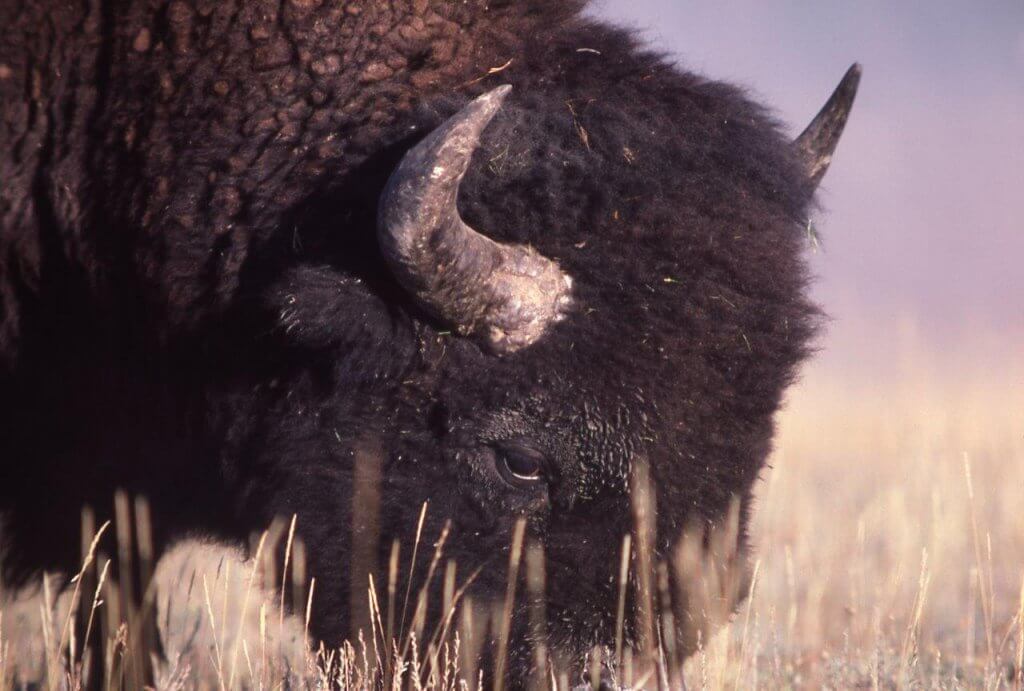
For thousands of years buffalo were honored by Native Americans of the Plains in story, song, dance and ceremonials. They lived together in harmony, interconnected physically and spiritually. Photo NPS, J Schmidt.
The buffalo is celebrated as sacred by the Plains Indians in stories, songs, dances, artwork and religious symbols and ceremonials.
For thousands of years buffalo were intimately connected with the Indian culture, both physically and spiritually.
They were considered as relatives who protect the people and deserve protection and gratitude in return. As brothers and sisters, they lived together in harmony.
In traditional Plains belief, buffalo gave themselves up willingly as food for Native people, and furnished many other gifts as well.
Daily the people thanked the buffalo and prayed for them to continue helping them survive.
Storytelling an Art
Storytelling was an art. The people recognized certain restrictions and taboos. Some stories were passed down by a certain medicine man—and he alone was allowed to tell them.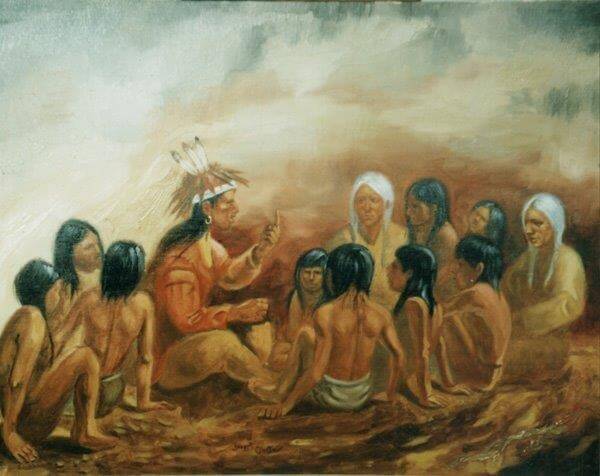
Telling stories was an art and an important way of passing down religious beliefs, history and tribal culture. The same traditions in several variations might be told by storytellers from different tribes, especially if they shared kinship or traded with each other.
Restrictions and taboos applied. Certain stories were passed down to a specific medicine man, and he alone was allowed to tell them. Traditional beliefs were taught at a grandmother’s knee—or by grandfathers.
There were stories of the origin of buffalo—and people—the flood that covered the earth, the close connections of the people with the spirit world of their relatives—buffalo and other wildlife and birds.
Other stories modeled good behavior such as kindness to the less fortunate and the generosity of every good hunter in sharing his game.
Stories and traditions of Native people are told for different reasons—to teach, to entertain, to ridicule, to cause fear or laughter. All bring the knowledge of elders to younger generations.
Traditional storytellers believe the old stories are best told in the native language and to listeners who understand their culture.
They say an amusing story is “not as funny” in English. Much of the spirit, humor and excitement get lost in translation.
Not always did the traditional stories provide religious or cultural significance or even teach a lesson. Often the venerable grandmother, with a twinkle in her eye, entertained children with hilarious tales about coyote tricksters and other mischief.
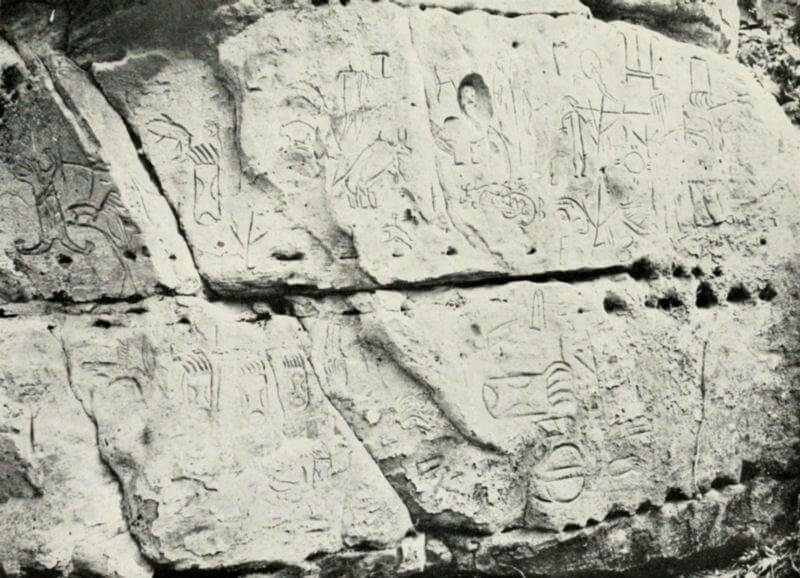
Petroglyphs carved into rocks in Nebraska mark a notable place of religious ceremony. Photo Smithsonian.
Cave of Origin
The creation of humans and buffalo as emerging from a cave or hole in the ground is a traditional belief held by many Plains tribes.
For many Lakota that cave is Wind Cave in the southern Black Hills, one of the world’s longest caves. The pine-covered hills there are coursed throughout with large caves, interconnected through a network of tight honeycombed passages.
A Pawnee traditional belief tells of the beginning of the world from such a cave or hole.
Long ago all living things waited far underground. Great herds of buffalo lay there, all the people, antelope, wolves, deer, rabbits, and even the little bird that sang ‘tear-tear.’ They waited as if asleep.
One day Buffalo Woman awoke, stretched and began to walk slowly among the others touching them lightly. As she did they began to stir and stretch.
She headed toward an opening where she saw a great shining light and felt warmth streaming into the cave.
A young cow rose and followed her. Then came another buffalo and another and soon a great line was moving out of the opening into the bright, warm, grassy place that was the earth.
Next the people woke up and streamed out one by one, followed by all the other animals and even the small tear-tear bird flying toward the warming sun.
They spread out in all four directions toward the circling horizon. And the people knew they were in the right place, the place where they would live well, together with their relatives, the buffalo.
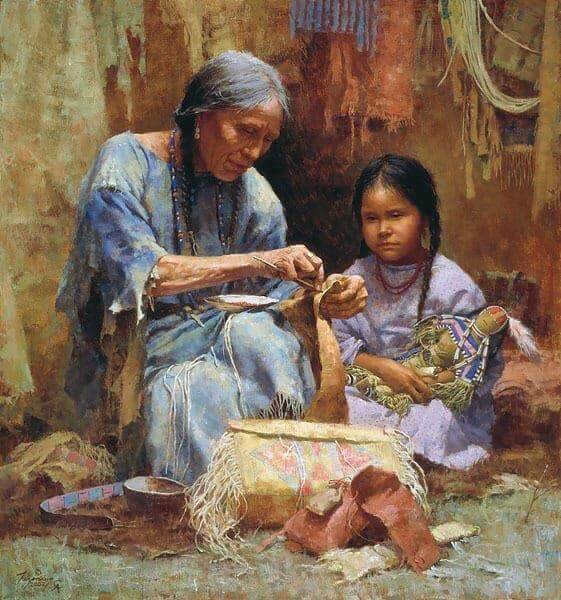
Stories and traditions of Native people are told for different reasons—to teach, to entertain, to bring the knowledge of elders to younger generations. Painting credit Howard Terpning.
Grandmother gives Magic Bowls of Meat
Long ago, a tribe of Cheyenne hunters camped near a spring at the head of a small rushing stream. Farther downstream the creek disappeared into a deep hole.
The people were starving and could find no food, not even a rabbit or a grouse.
One day the Chief called a council meeting. “We must explore the hole,” he said. “It may be dangerous, but we have brave hunters. Who will go?”
No one responded. Finally, one young brave painted himself for hunting and stepped up. “I will go and sacrifice myself for our people.”
He arrived at the hole, and to his surprise, he found two other Cheyenne hunters near the opening, where the stream rushed underground.
“Are you here to taunt me,” the young hunter asked. “Will you only pretend to jump when I do?”
“No, you are mistaken about us. We really do want to come into the hole with you,” they said.
They then joined hands and together jumped down into the opening. They fell into deep darkness. Finally their eyes began to adjust, and they discovered a door.
The first hunter knocked, but there was no response. He knocked again, louder.
“Who are you and what do you want, my brave ones?” asked an old Indian grandmother as she opened her door.
“Grandmother, we are searching for food for our hungry people,” the young man replied. “Our tribe never seems to have enough to eat.”
“Are you hungry now?” she asked.
“Oh, yes, kind Grandmother, we are very hungry,” all three braves answered.
She opened her door wide, inviting them in.
“Look out there!” she pointed out her window.
beautiful wide prairie stretched before their eyes. The young hunters could hardly believe what they saw! To their surprise, great herds of buffalo grazed there contentedly.
Then she seated the hunters and brought each of them a stone bowl full of buffalo stew. It was delicious. They ate their fill and still more meat remained in their bowls!
“Take these special bowls of buffalo meat back to your hungry people,” the grandmother said. “Tell them that soon I will send buffalo.”
“Thank you, thank you, thank you, kind Grandmother,” said the three young Cheyenne braves.
They helped each other climb back up the hole without spilling any of the buffalo meat out of the bowls.
As they climbed out of the hole, their people were delighted to see them safe.
And even happier that they brought delicious food. Everyone in the camp ate heartily and rejoiced over the tasty new food. And though all ate their fill, still more meat remained in the old grandmother’s three magic bowls.
When the Cheyenne waked at dawn the next day, they looked out of their tepees and could scarcely believe the vast herds of buffalo that had mysteriously appeared, surrounding their village and covering the hills and prairies far into the distance.
They knew this would be a good supply of food, shelter and clothing for their people.
Gratefully they gave thanks to the spirit grandmother and to the buffalo for their generosity.
http://www.firstpeople.us/FP-Html-Legends/OriginoftheBuffalo-Cheyenne.html)

Teams of young men drag the sagebrush as a first step in building a Medicine Lodge. Historic photo from Smithsonian files.
White Buffalo Woman Brings Pipe
White Buffalo Woman is a holy being who figures powerfully into Plains lore. Although she first appeared in human form, she is also a buffalo, one of the brothers and sisters who gave their flesh so the people could live.
One summer long ago the Sans Arc band of Teton Sioux had nothing to eat and people were starving.
Two young men went out hunting but could find nothing all morning.
Then toward them came a beautiful young maiden in beautiful fringed white buckskin that shone in the sun. She said she brought a message from the buffalo nation.
One of the hunters reached out to touch her with disrespect. As he did so a cloud dropped over him and when it lifted, only his skeleton lay there, scorched and burned.
The other young man treated her with awe and respect. She told him to go back to camp without looking back and tell the people to prepare a medicine lodge for her visit at sunrise.
At daybreak the White Buffalo Woman came toward their camp, holding the sacred buffalo calf pipe.
She told them the pipe was a peacemaker, and that their tribe was especially selected for good qualities and reverence toward sacred things.
She talked to the women, “You have a hard life, yet without you this life would not be what it is. The Great Spirit is with you in your sorrows. He has given you the great gift of kindness. He knows you love your children dearly.”
To the children she said, “Your parents love you and have made many sacrifices for your sake.
“Learn to respect and reverence this pipe and, above all, lead pure lives.
And to the men she said, “My dear brothers, in giving you this pipe you are expected to use it for nothing but good purposes.
“When you are in need of buffalo meat, smoke this pipe and ask for what you need and it shall be granted you.
“On you it depends to be a strong help to the women in raising of children. Share the women’s sorrow. The Great Spirit smiles on the man who has kind feelings for a woman. Be good and kind to the little children.”
She showed them how to use the pipe. Then as White Buffalo Woman walked away toward the setting sun, she rolled over four times.
The first time she changed into a black buffalo calf, the next time a brown calf, then a red calf. The fourth time she rolled, she changed into a white female buffalo calf.
As the white calf disappeared from sight over a nearby hill, great numbers of buffalo came down the hill, allowing themselves to be killed. This was so that their relatives, the people, might survive.
From that day the buffalo furnished the people with all the food they needed, skins for their tipis, warm clothing, bones for tools and sacred items for religious ceremonies.
The tribe named the sacred pipe the White Buffalo Calf pipe. It is said that their Chief Buffalo Stands Upward received it from the White Buffalo Maiden herself.
Elk Head, the keeper of the pipe when Frances Densmore recorded this story in 1918, was said to be 98 years of age. He died soon after. Each previous keeper of the pipe lived to be more than a hundred years old, Densmore was told. Two very old tribal pipes were said to be kept by the Looking Horse family at Eagle Butte in South Dakota (Densmore).
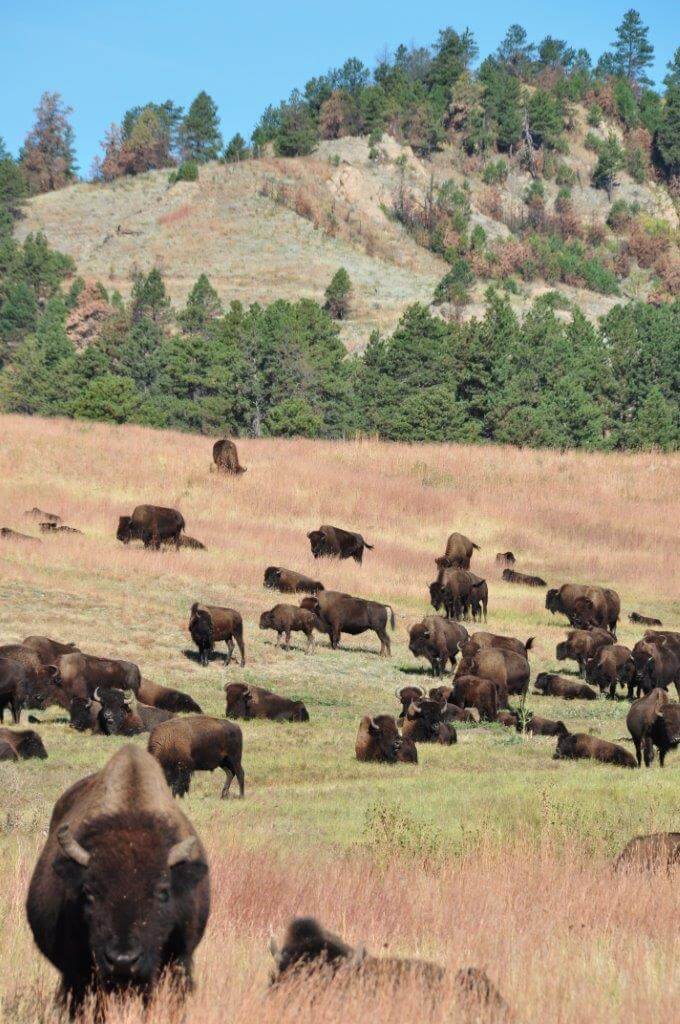
In traditional belief the buffalo were put on earth to feed the Native people. They gave themselves up willingly as food and brought many other gifts as well—hide for tipis, blankets and clothing and bones for religious ceremonies, tools, sleds, ornaments and toys. Photo SD Game, Fish and Parks.
How the Buffalo Escaped from Humpback
An Apache/ Comanche tradition tells of the release of buffalo before they ran freely over the earth.
A powerful being named Humpback owned all the buffalo. He kept them locked in a stone corral in the southern mountains where he lived with his young son.
He shared them with no one else and refused to give any meat to his neighbors, even though they were starving.
The people sought help from the wily Coyote.
Coyote called them into Council. “Let’s go over to Humpback’s corral and make a plan to release the buffalo.”
After dark Coyote and the hunters inspected the corral. The thick stone walls rose too high to climb and there was no gate—only an entrance that led through the back door of Humpback’s house.
For four days they watched the father, his son and the buffalo from behind a brushy hideout.

Paintings on buffalo hides could tell a story or mark the passing of time in a more permanent way. CM Russell.
The next morning when the boy went to the spring for water he found a small dog there drinking.
He picked up the dog, laughed, snuggled and played with it and carried it back home.
“See my nice puppy!” he said. “I want to keep him for a pet.”
“Take him back! A dog is good for nothing,” his father scolded.
“Besides he’s probably not a real dog—some schemer has done this to get our buffalo.
“Look—we’ll test him.”
He held a hot coal from the fire close to the puppy’s eyes. It barked three times.
“All right. It probably is a real dog,” decided Humpback. “You can keep it. But only if it stays away from the buffalo.”
That night when father and son went to sleep, Coyote opened the back door and ran to the buffalo, barking and nipping at their heels.
The terrified buffalo had never been chased by a dog before. They stampeded through the house, smashing down the front door.
Humpback awoke and tried to stop them, but could not hold them back.
Every buffalo escaped and ran up and over the green hills, scattering across the earth.
Coyote ran after them and the people danced with joy.
After the last one had galloped away, Humpback’s son looked for his small dog. “Where is my puppy?” he cried. “I want my pet puppy dog.”
“That was not a dog!” Humpback shouted angrily. “It was Coyote the Trickster. He fooled us. See him out there dancing with the people.
“He turned loose all our buffalo and we can never get them back again.”
(http://darkwell.com/lor297.htm )
The Buffalo was part of us, his flesh and blood being absorbed by us until it became our own flesh and blood.
Our clothing, our tipis, everything we needed for life came from the buffalo’s body. It was hard to say where the animals ended and the human began.
– John (Fire) Lame Deer, Oglala-Lame Deer Seeker of Visions
(with Richard Erdoes, 1972)

Francie M Berg
Author of the Buffalo Tales &Trails blog


